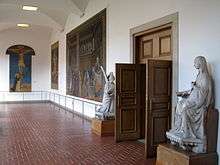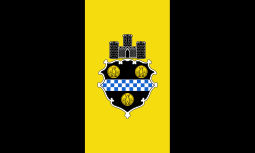Frick Fine Arts Building
The Henry Clay Frick Fine Arts Building is a landmark Renaissance villa and a contributing property to the Schenley Farms-Oakland Civic Historic District[2][3] on the campus of the University of Pittsburgh in Pittsburgh, Pennsylvania, United States. The Frick Fine Arts Building sits on the southern edge of Schenley Plaza, opposite The Carnegie Institute, and is the home of Pitt's History of Art and Architecture Department, Studio Arts Department, and the Frick Fine Arts Library. Before its front steps is Mary Schenley Memorial Fountain.
Henry Clay Frick Fine Arts Building | |
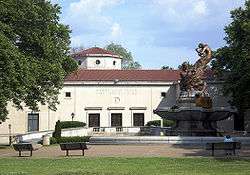 The Frick Fine Arts Building at the University of Pittsburgh sits behind the Schenley Fountain | |
| Coordinates | 40°26′30.11″N 79°57′4.50″W |
|---|---|
| Built | 1962–1965 |
| Architect | Burton Kenneth Johnstone |
| Architectural style | Neo-Renaissance |
| Part of | Schenley Farms Historic District (ID83002213[1]) |
| Added to NRHP | July 22, 1983 |
History

The Frick Fine Arts Building sits on the site of the former Schenley Park Casino, Pittsburgh's first multi-purpose arena with an indoor ice skating rink, sat on the location of the building before burning down in December 1896.[4]
The building itself is a gift of Helen Clay Frick (1888–1984), daughter of the Pittsburgh industrialist and art patron Henry Clay Frick (1849–1919). She established the Fine Arts Department at the University of Pittsburgh in 1926 and continued to fund it through the 1950s, when she first made a commitment to create a separate structure to house it.[5] Land for the project was donated to the university by the City of Pittsburgh.
In early negotiations with the University of Pittsburgh, Miss Frick asked that successors to the New York architects Carrère and Hastings design the new facility after the Italian palazzo its firm had built in Manhattan for her father some fifty years earlier. Eventually, however, both parties agreed to Burton Kenneth Johnstone Associates as the architects. Its design is modeled after Pope Julius III's (1487–1555) Villa Giulia in Rome, Italy. The building is constructed of white limestone and marble with a terracotta tile roof around a central courtyard. An octagonal cupola, which caps the central rotunda, rises 45 feet above the ground.[5] The building houses the University of Pittsburgh's Department of History of Art and Architecture, and contains classrooms, an open cloister, an art gallery, a 200-seat auditorium, as well as a research library. Construction began in 1962 and the building was opened in May 1965.
By the late 1960s Miss Frick, unhappy that the university did not conform to her restrictions on management of both the department and the new building, severed her ties with the University of Pittsburgh. She responded by creating a new venture, The Frick Art Museum, on the property of her ancestral home, Clayton, a few miles east in Pittsburgh's Point Breeze neighborhood. That museum operates today as a part of the Frick Art & Historical Center complex.
Building use and features
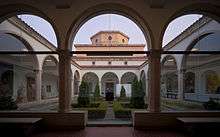
The Frick Fine Arts Building consists of classrooms, a library, and art galleries around an open cloister and contains a 45 feet (14 m) high octagon capped by a pyramidal roof.[6]
A noted 1965 low relief portrait of Henry Clay Frick by Malvina Hoffman in limestone sits above the entrance to the building. Hoffman was 79 years old when she accepted the commission. She could not sculpt it herself because union rules prevented sculptors from working on a relief attached to a building. However, she climbed up on the scaffolding to oversee the completion of the work.[7][8] Inside the main entrance, a neon work by contemporary Chinese artist Gu Wenda is installed in the lobby.[9]
The building also contains a 200-seat auditorium that is used for lectures, performances, and special events.[10]
Nicholas Lochoff Cloister
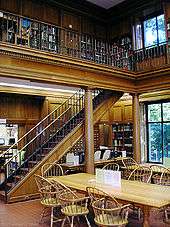
The Nicholas Lochoff Cloister is a main feature of the Frick Fine Arts Building. Its large paintings of Italian masterpieces are scale reproductions that were commissioned in 1911 from Nicholas Lochoff by the Moscow Museum of Fine Arts (now the Pushkin Museum of Fine Arts). Lochoff worked slowly and carefully. Only a few paintings were completed and sent back to Russia by the Russian Revolution of 1917. Lochoff, unable to return because of new communist regime, felt compelled to sell off the paintings. Buyers included Harvard University and the Frick Art Reference Library in New York. Miss Frick acquired the entire collection, however, after Lochoff's death, with the help of art critic Bernard Berenson. In 2003, the paintings were cleaned and restored by Christine Daulton. Also in the gallery are noted Carrara marble reproductions of 14th century Annunciation figures by sculptor Alceo Dossena.[11]
Frick Fine Arts Library
Located in Frick Fine Arts Building, this two-story library houses a circulating research collection serving the Department of the History of Art and Architecture. The Collection contains over 90,000 volumes and subscribes to more than 350 journals in relevant fields and is ranked among the top 10 fine art libraries in the country.[12][13] The library's reading room is constructed of fruit wood paneling and cabinetwork with gold leaf trim designed by Italian craftsmen. The library is further appointed by wrought iron balcony railings, terracotta tile flooring, maple tables with matching Windsor chairs, and ceiling-high windows furnishing views of Schenley Park. An inscription on the wall facing the entrance indicates the libraries dedication to Henry Clay Frick.[5]
University Arts Gallery
The permanent collection contains a collection of prints and graphic works dating from the 16th through 20th centuries and regularly hosts changing exhibitions sponsored by the Department of the History of Art and Architecture and the Friends organization. Some of the more prominent pieces in the permanent collection include a large collection of Jacques Callot and Gertrude Quastler prints; 16th-18th century drawings from the Clapp and Denny families; a collection of 19th and 20th century photography; the Gimbel collection of American art; and various Japanese prints, Asian ceramics, portraits, and Pittsburgh-related paintings by Hetzel, Gorson, and Kane.[5]
Popular culture
The Frick Fine Arts Building appeared in scenes set at the University of Pittsburgh on an episode of As the World Turns that aired on November 12, 2002.[14]
Gallery


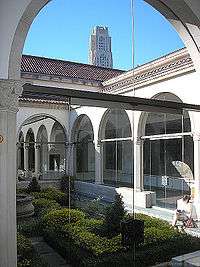

 Frick Fine Arts Auditorium
Frick Fine Arts Auditorium Frick Fine Arts main entrance lobby
Frick Fine Arts main entrance lobby
 Nicholas Lochoff Gallery
Nicholas Lochoff Gallery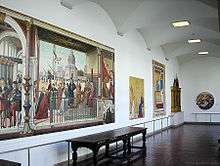 Nicholas Lochoff Gallery
Nicholas Lochoff Gallery- The back of the Frick Fine Arts Building
- The Spanish War memorial is a copy of The Hiker (1925) by Allen Newman and sits on the left side of Frick Fine Arts
References
- "National Register Information System". National Register of Historic Places. National Park Service. July 9, 2010.
- "Oakland Civic Center City Designated Historic District" (PDF). City of Pittsburgh Historic Review Commission. Archived from the original (PDF) on 2010-01-08. Retrieved 2010-02-08.
- Sajna, Mike (1997-01-23). "Hearing set on historic landmark nomination for two Pitt buildings". University Times. 29 (10). Pittsburgh, PA: University of Pittsburgh. Retrieved 2010-02-08.
- "Archived copy" (PDF). Archived from the original (PDF) on 2010-06-27. Retrieved 2009-06-22.CS1 maint: archived copy as title (link)
- http://www.haa.pitt.edu/resources/documents/ffab.pdf Archived June 27, 2010, at the Wayback Machine
- Toker, Franklin (2009). Pittsburgh: A New Portrait. Pittsburgh, PA: University of Pittsburgh Press. p. 335. ISBN 978-0-8229-4371-6.
- "Office of Public Art - Greater Pittsburgh Arts Council" (PDF). Publicartpittsburgh.org. Retrieved 2012-08-16.
- Archived June 10, 2007, at the Wayback Machine
- "History of Art and Architecture: Permanent Collection". University of Pittsburgh. Retrieved February 4, 2013.
- "Media Enhanced Classrooms: Frick Fine Arts 125". University of Pittsburgh Center or Instructional Development & Distance Education. September 30, 2011. Archived from the original on June 8, 2013. Retrieved February 4, 2013.
- Miller, Donald (1968-12-05). "Pitt Fakes Given New Importance". Pittsburgh Post-Gazette. Archived from the original on 2012-07-12. Retrieved 2010-02-01.
- "Frick Fine Arts Library - University Library System - University of Pittsburgh". Library.pitt.edu. Archived from the original on 2012-05-25. Retrieved 2012-08-16.
- Archived August 19, 2007, at the Wayback Machine
- "Students, Staff Debut on As the World Turns". Pitt Chronicle. Pittsburgh, PA: University of Pittsburgh. 2002-11-11. Archived from the original on 2010-07-15. Retrieved 2010-07-02.
- Alberts, Robert C. (1987). Pitt: the story of the University of Pittsburgh 1787–1987. University of Pittsburgh Press. ISBN 0-8229-1150-7.
- Marylynne Pitz (2003). Pittsburgh Post-Gazette: Rare murals being restored in Pitt fine arts building. Retrieved May 23, 2007.
- Toker, Franklin (1994) [1986]. Pittsburgh: An Urban Portrait. Pittsburgh: University of Pittsburgh Press. ISBN 0-8229-5434-6.
External links
| Wikimedia Commons has media related to Frick Fine Arts Building. |
Art Gallery
Departments
Panorama
Video
| Preceded by Forbes Hall |
University of Pittsburgh Buildings Frick Fine Arts Building Constructed: 1962–1965 |
Succeeded by School of Information Sciences Building |
